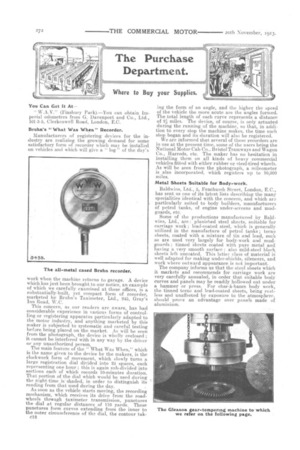The Purchase Purchase Department.
Page 18

If you've noticed an error in this article please click here to report it so we can fix it.
Where to Buy your Supplies.
You Can Get It At " W.A.Y." (Finsbury Park).—You can obtain Imperial odometers from G. Davenport and Co., Ltd., 101-3-5, Clerkenwell Road, London, E.C.
Bruhn's "What Was When" Recorder.
Manufacturers of registering devices for the industry are realizing the growing demand for some satisfactory form of recorder which may be installed on vehicles and which will give a " log" of the day's work when the machine returns to garage. A device which has just been brought to our notice, an example of which we carefully examined at these offices, is a substantially-built, yet compact form of recorder, marketed by Bruhn's Taximeter, Ltd., 245, Gray's Inn Road, W.C.
This concern, as our readers are aware, has had considerable experience in various forms of controlling or registering apparatus particularly adapted to the motor industry, and anything marketed by this maker is subjected to systematic and careful testing before being placed on the market. As will be seen from the photograph, the device is wholly enclosed ; it cannot be interfered with in any way by the driver or any unauthorized person. The main feature of the "What Was When," which is the name given to the device by the makers, is the clockwork form of movement, which slowly turns a large registration dial divided into 24 spaces, each representing one hour ; this is again sub-divided into sections each of which records 10-minutes duration.
That portion of the dial which would be used during•the night-time is' shaded, in order to distinguish its
reading from that used during the day.. As soon as the vehicle starts moving, the recording mechanism, which receives its drive from the roadwheels thrangh taximeter transmission, punctures the dial at regular distances of 110 yards. These punctures form curves extending from the inner to the outer circumference of the dial, the contour ink 018
ing the form of an angle, and the higher the speed of the vehicle the more acute are the angles formed. The total length of each curve represents a distance of 2;t1 miles. The device, of course, is only actuated during the running of the machine, so that, in addition to every stop the machine makes, the time such stop began and its duration will also be registered.
We are informed that several of these recorders are in use at the present time, some of the users being the National Motor Cab Co., Bristol Tramways and Wagon Co., Harrods, etc.. The maker has no hesitation in installing them on all kinds of heavy commercial vehicles fitted with either rubber or steel-tired wheels. As will be seen from the photograph, a mileometer is also incorporated, which registers up to 10,000 miles.
Metal Sheets Suitable for Body-work.
Baldwins, Ltd., 5, Fenchurch Street., London, E.C., has sent us one of its latest lists describing the many specialities identical with the concern, and which are particularly suited to body builders, manufacturers of petrol tanks, of engine under-screens and mudguards, etc.
Some of the productions manufactured by Baldwins, Ltd., are : planished steel sheets, suitable for carriage work ; lead-coated steel, which is generally utilized in the manufacture of petrol tanks ;_ terne sheets, coated with a mixture of tin and lead, such as are used very largely for body-work and mudguards ; tinned sheets coated with pure metal and having a very smooth surface ; also mild-steel black sheets left uncoated. This latter class of material is well adapted for making under-shields, silencers, and work where outward appearance is not important.
The company informs us that the steel sheets which it markets and recommends for carriage work are very carefully annealed, in order that suitable body curves arid panels may be readily hollowed out under a hammer or press. For char--banes body work, the tinned terne and lead-coated sheets, being rustless and unaffected by exposUre to the atmosphere, should prove an advantage over panels made of aluminium.






















